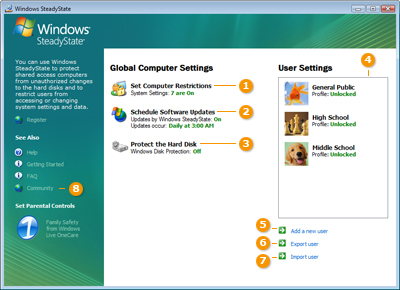The main screen of Windows SteadyState is your starting place to access each setting and restriction you can apply. These settings are divided into two types of settings, as shown in Figure 1:
- Computer Settings—Use these settings
to protect and schedule software updates for the entire
computer.
- User Settings—Use these settings to
configure and restrict specific user accounts.
Additional information on the settings and options available in the Windows SteadyState main dialog box are provided in Table 2.
 Note: Note: |
|---|
| For additional information and support, the left navigation pane of Windows SteadyState includes links to several resources, such as the Windows SteadyState Community Web site. |
Figure 1: Settings and options in the Windows SteadyState main dialog box.

Table 2: Description of Settings and Options in Windows SteadyState
| Setting or option | Description |
|---|---|
|
1. Set Computer Restrictions |
|
|
2. Schedule Software Updates |
|
|
3. Protect the Hard Disk |
|
|
4. User Profiles |
|
|
5. Add a New User |
|
|
6. Export User |
|
|
7. Import User |
|
|
8. Additional Support |
|





